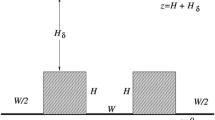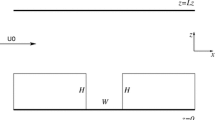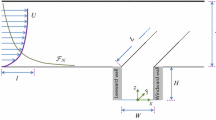Abstract
The scalar dynamics within a unit-aspect-ratio street canyon are studied using large-eddy simulation. The key processes of ventilation and mixing are analysed with the canyon-averaged concentration, mean tracer age and variance. The results are sensitive to the source location and can be classified according to the streamline geometry. The canyon-averaged concentrations for the corner vortices, vortex sea and central vortex do not converge to the same value at large times, though the mean decay rates do. The variance measured with respect to the canyon average shows two distinct decay regimes: the early regime reflects large-scale straining and enhanced diffusion across streamlines, while the late regime is associated with escape from the canyon, i.e., ventilation. Analytical predictions for the variance-decay or mixing time scales are verified for the early regime. It is argued that the presence of an open boundary at the roof level suppresses rapid mixing of the scalar field and is responsible for differences with respect to scalar dynamics within closed domains.

















Similar content being viewed by others
Notes
The characteristic scale of the scalar field is assumed to be large compared to the dissipation scale.
The requirement of global control, i.e., a velocity scale comparable to the size of the (closed) domain, is not strictly satisfied either. For an open domain, however, restricting the analysis to the canyon interior, \(z<H\), is analogous.
Since the members of the set are not identical, errors are estimated from the standard deviation of the entire set.
References
Batchelor GK (1956) On steady laminar flow with closed streamlines at large reynolds number. J Fluid Mech 1:177–190. https://doi.org/10.1017/S0022112056000123
Belcher S, Coceal O, Goulart E, Rudd A, Robins A (2015) Processes controlling atmospheric dispersion through city centres. J Fluid Mech 763:51–81
Belcher SE (2005) Mixing and transport in urban areas. Philos Trans R Soc A 363(1837):2947–2968. https://doi.org/10.1098/rsta.2005.1673
Bennett AF (1984) Relative dispersion: local and nonlocal dynamics. J Atmos Sci 41(11):1881–1886. https://doi.org/10.1175/1520-0469(1984)041<1881:RDLAND>2.0.CO;2
Blocken B (2015) Computational fluid dynamics for urban physics: Importance, scales, possibilities, limitations and ten tips and tricks towards accurate and reliable simulations. Build Environ 91:219–245. https://doi.org/10.1016/j.buildenv.2015.02.015
von Bremen HF, Udwadia FE, Proskurowski W (1997) An efficient QR based method for the computation of Lyapunov exponents. Physica D 101:1–16. https://doi.org/10.1016/S0167-2789(96)00216-3
Britter RE, Hanna SR (2003) Flow and dispersion in urban areas. Annu Rev Fluid Mech 35(1):469–496
Brown MJ, Lawson R, DeCroix D, Lee R (2000) Mean flow and turbulence measurements around a 2-d array of buildings in a wind tunnel. In: 11th joint AMS/AWMA conference on the applications of air pollution meteorology, Long Beach, CA
Buccolieri R, Salim SM, Leo LS, Sabatino SD, Chan A, Ielpo P, de Gennaro G, Gromke C (2011) Analysis of local scale tree-atmosphere interaction on pollutant concentration in idealized street canyons and application to a real urban junction. Atmos Environ 45(9):1702–1713. https://doi.org/10.1016/j.atmosenv.2010.12.058
Chang JC, Hanna SR (2004) Air quality model performance evaluation. Meteorol Atmos Phys 87(1):167–196. https://doi.org/10.1007/s00703-003-0070-7
Chen F, Kusaka H, Bornstein R, Ching J, Grimmond CSB, Grossman-Clarke S, Loridan T, Manning KW, Martilli A, Miao S, Sailor D, Salamanca FP, Taha H, Tewari M, Wang X, Wyszogrodzki AA, Zhang C (2011) The integrated WRF/urban modelling system: development, evaluation, and applications to urban environmental problems. Int J Climatol 31:273–288. https://doi.org/10.1002/joc.2158
Cheng WC, Liu CH (2011) Large-eddy simulation of flow and pollutant transports in and above two-dimensional idealized street canyons. Bound Layer Meteorol 139(3):411–437. https://doi.org/10.1007/s10546-010-9584-y
Cui Z, Cai X, Baker CJ (2004) Large-eddy simulation of turbulent flow in a street canyon. Q J R Meteorol Soc 130(599):1373–1394. https://doi.org/10.1256/qj.02.150
Deardorff J (1980) Stratocumulus-capped mixed layers derived from a three-dimensional model. Bound Layer Meteorol 18(4):495–527
DePaul F, Sheih C (1985) A tracer study of dispersion in an urban street canyon. Atmos Environ 19(4):555–59. https://doi.org/10.1016/0004-6981(85)90034-4
Duan G, Ngan K (2018) Effects of time-dependent inflow perturbations on turbulent flow in a street canyon. Bound Layer Meteorol 167(2):257–284. https://doi.org/10.1007/s10546-017-0327-1
Eichhorn J (2004) Application of a new evaluation guideline for microscale flow models. In: 9th international conference on harmonisation within atmospheric dispersion modeling for regulatory purposes, Garmisch-Partenkirchen, Germany, June 1–4
Fox RO (2003) Computational models for turbulent reacting flows. Cambridge University Press, Cambridge
Franke J, Hellsten A, Schlünzen KH, Carissimo B (2007) Best practice guideline for the CFD simulation of flows in the urban environment: COST action 732 quality assurance and improvement of microscale meteorological models. Technical Report, COST Office, Brussels
Ganzeveld L, Eerdekens G, Feig G, Fischer H, Harder H, Königstedt R, Kubistin D, Martinez M, Meixner FX, Scheeren HA, Sinha V, Taraborrelli D, Williams J, Vilà-Guerau de Arellano J, Lelieveld J (2008) Surface and boundary layer exchanges of volatile organic compounds, nitrogen oxides and ozone during the gabriel campaign. Atmos Chem Phys 8(20):6223–6243. https://doi.org/10.5194/acp-8-6223-2008
Grabowski W, Smolarkiewicz P (1999) Crcp: a cloud resolving convection parameterization for modeling the tropical convecting atmosphere. Physica D Nonlinear Phenom 133(1–4):171–178
Gromke C, Ruck B (2012) Pollutant concentrations in street canyons of different aspect ratio with avenues of trees for various wind directions. Bound Layer Meteorol 144(1):41–64. https://doi.org/10.1007/s10546-012-9703-z
Hall TM, Plumb RA (1994) Age as a diagnostic of stratospheric transport. J Geophys Res Atmos 99(D1):1059–1070
Hang J, Sandberg M, Li Y (2009) Age of air and air exchange efficiency in idealized city models. Build Environ 44(8):1714–1723. https://doi.org/10.1016/j.buildenv.2008.11.013
Haynes PH, Vanneste J (2005) What controls the decay of passive scalars in smooth flows? Phys Fluids 17(9):097103. https://doi.org/10.1063/1.2033908
Haynes PH, Vanneste J (2014) Dispersion in the large-deviation regime. Part 1: shear flows and periodic flows. J Fluid Mech 745:321–350
Holzer M (1999) Analysis of passive tracer transport as modeled by an atmospheric general circulation model. J Clim 12(6):1659–1684
Kataoka H, Mizuno M (2002) Numerical flow computation around aeroelastic 3D square cylinder using inflow turbulence. Wind Struct 5:379–392. https://doi.org/10.12989/was.2002.5.2_3_4.379
Kim PS, Jacob DJ, Mickley LJ, Koplitz SN, Marlier ME, DeFries RS, Myers SS, Chew BN, Mao YH (2015) Sensitivity of population smoke exposure to fire locations in Equatorial Asia. Atmos Environ 102:11–17. https://doi.org/10.1016/j.atmosenv.2014.09.045
Lapeyre G, Klein P, Hua BL (1999) Does the tracer gradient vector align with the strain eigenvectors in 2D turbulence? Phys Fluids 11:3729–3737
Letzel MO, Krane M, Raasch S (2008) High resolution urban large-eddy simulation studies from street canyon to neighbourhood scale. Atmos Environ 42(38):8770–8784
Letzel MO, Helmke C, Ng E, An X, Lai A, Raasch S (2012) LES case study on pedestrian level ventilation in two neighbourhoods in Hong Kong. Meteorol Z 21(6):575–589. https://doi.org/10.1127/0941-2948/2012/0356
Li XX, Liu CH, Leung DYC, Lam KM (2006) Recent progress in CFD modelling of wind field and pollutant transport in street canyons. Atmos Environ 40(29):5640–5658
Liu CH, Barth MC (2002) Large-eddy simulation of flow and scalar transport in a modeled street canyon. J Appl Meteorol 41(6):660–673
Liu CH, Leung DYC, Barth MC (2005) On the prediction of air and pollutant exchange rates in street canyons of different aspect ratios using large-eddy simulation. Atmos Environ 39(9):1567–1574
Lo KW, Ngan K (2015a) Characterising the pollutant ventilation characteristics of street canyons using the tracer age and age spectrum. Atmos Environ 122:611–621. https://doi.org/10.1016/j.atmosenv.2015.10.023
Lo KW, Ngan K (2015b) Predictability of turbulent flow in street canyons. Bound Layer Meteorol 156(2):191–210. https://doi.org/10.1007/s10546-015-0014-z
Lo KW, Ngan K (2017) Characterizing ventilation and exposure in street canyons using Lagrangian particles. J Appl Meteorol Climatol 56(5):1177–1194. https://doi.org/10.1175/JAMC-D-16-0168.1
Lund TS, Wu X, Squires KD (1998) Generation of turbulent inflow data for spatially-developing boundary layer simulations. J Comput Phys 140(2):233–258
Maronga B, Gryschka M, Heinze R, Hoffmann F, Kanani-Sühring F, Keck M, Ketelsen K, Letzel MO, Sühring M, Raasch S (2015) The parallelized large-eddy simulation model (PALM) version 4.0 for atmospheric and oceanic flows: model formulation, recent developments, and future perspectives. Geosci Model Dev 8(8):2515–2551. https://doi.org/10.5194/gmd-8-2515-2015
Masson V (2006) Urban surface modeling and the meso-scale impact of cities. Theor Appl Climatol 84:35–45. https://doi.org/10.1007/s00704-005-0142-3
Meroney RN, Pavageau M, Rafailidis S, Schatzmann M (1996) Study of line source characteristics for 2-D physical modelling of pollutant dispersion in street canyons. J Wind Eng Ind Aerodyn 62(1):37–56. https://doi.org/10.1016/S0167-6105(96)00057-8
Michioka T, Sato A, Takimoto H, Kanda M (2011) Large-eddy simulation for the mechanism of pollutant removal from a two-dimensional street canyon. Bound Layer Meteorol 138(2):195–213
Michioka T, Takimoto H, Sato A (2014) Large-eddy simulation of pollutant removal from a three-dimensional street canyon. Bound Layer Meteorol 150(2):259–275. https://doi.org/10.1007/s10546-013-9870-6
Ngan K, Lo K (2015) Revisiting the flow regimes for urban street canyons using the numerical Green’s function. Environ Fluid Mech. https://doi.org/10.1007/s10652-015-9422-3
Ngan K, Vanneste J (2011) Scalar decay in a three-dimensional chaotic flow. Phys Rev E 83(056):306
Ngan K, Straub DN, Bartello P (2004) Three-dimensionalization of freely-decaying two-dimensional turbulence. Phys Fluids 16:2918–2932. https://doi.org/10.1063/1.1763191
Oke TR (1988) Street design and urban canopy layer climate. Energy Build 11:103–113. https://doi.org/10.1016/0378-7788(88)90026-6
Ott E (2002) Chaos in dynamical systems. Cambridge University Press, Cambridge
Ottino JM (1989) The kinematics of mixing: stretching, chaos, and transport. Cambridge University Press, Cambridge
Park SB, Baik JJ (2013) A large-eddy simulation study of thermal effects on turbulence coherent structures in and above a building array. J Appl Meteorol Climatol 52(6):1348–1365
Park SB, Baik JJ, Han BS (2013) Large-eddy simulation of turbulent flow in a densely built-up urban area. Environ Fluid Mech 15(2):235–250. https://doi.org/10.1007/s10652-013-9306-3
Pavageau M, Schatzmann M (1999) Wind tunnel measurements of concentration fluctuations in an urban street canyon. Atmos Environ 33:3961–3971. https://doi.org/10.1016/S1352-2310(99)00138-7
Pfister G, Hess PG, Emmons LK, Lamarque JF, Wiedinmyer C, Edwards DP, Pétron G, Gille JC, Sachse GW (2005) Quantifying CO emissions from the 2004 Alaskan wildfires using MOPITT CO data. Geophys Res Lett 32(11):L11809. https://doi.org/10.1029/2005GL022995
Pierrehumbert RT (1994) Tracer microstructure in the large-eddy dominated regime. Chaos Solitons Fractals 4(6):1091–1110
Rotach MW (1995) Profiles of turbulence statistics in and above an urban street canyon. Atmos Environ 29(13):1473–1486
Salman H, Haynes PH (2007) A numerical study of passive scalar evolution in peripheral regions. Phys Fluids 19(6):067101. https://doi.org/10.1063/1.2736341
Schauer JJ, Kleeman MJ, Cass GR, Simoneit BRT (2002) Measurement of emissions from air pollution sources. 4. C1–C27 organic compounds from cooking with seed oils. Environ Sci Technol 36(4):567–575. https://doi.org/10.1021/es002053m
Shraiman BI (1987) Diffusive transport in a Rayleigh–Bénard convection cell. Phys Rev A 36:261–267. https://doi.org/10.1103/PhysRevA.36.261
Shraiman BI, Siggia ED (2000) Scalar turbulence. Nature 405:639–646. https://doi.org/10.1038/35015000
Soulhac L, Salizzoni P, Cierco FX, Perkins R (2011) The model SIRANE for atmospheric urban pollutant dispersion; Part I, presentation of the model. Atmos Environ 45:7379–7395. https://doi.org/10.1016/j.atmosenv.2011.07.008
Waugh D, Hall T (2002) Age of stratospheric air: Theory, observations, and models. Rev Geophys 40(4):1-1–1-26. https://doi.org/10.1029/2000RG000101
Weil JC, Sullivan PP, Moeng CH (2004) The use of large-eddy simulations in Lagrangian particle dispersion models. J Atmos Sci 61(23):2877–2887. https://doi.org/10.1175/JAS-3302.1
Wicker LJ, Skamarock WC (2002) Time-splitting methods for elastic models using forward time schemes. Month Weather Rev 130(8):2088–2097. https://doi.org/10.1175/1520-0493(2002)130<2088:TSMFEM>2.0.CO;2
Wiggins S (1992) Chaotic transport in dynamical systems. Springer, New York
Williamson J (1980) Low-storage Runge–Kutta schemes. J Comput Phys 35(1):48–56
Yim S, Fung J, Lau A, Kot S (2009) Air ventilation impacts of the “wall effect” resulting from the alignment of high-rise buildings. Atmos Environ 43(32):4982–4994. https://doi.org/10.1016/j.atmosenv.2009.07.002
Acknowledgements
This work was supported by the Research Grants Council of Hong Kong (CityU 21304515). The authors thank Jacques Vanneste and an anonymous referee for helpful comments and suggestions.
Author information
Authors and Affiliations
Corresponding author
Additional information
Publisher's Note
Springer Nature remains neutral with regard to jurisdictional claims in published maps and institutional affiliations.
Appendices
Appendix 1: Lyapunov exponents
The stretching of fluid trajectories or the divergence of particles trajectories is governed by the velocity-gradient tensor. It has elements \(J_{ij}= \partial u_i/\partial x_j\). After discretising in time, (vector) perturbations evolve according to the map
For simplicity, \(dX_0={\varvec{I}}\). The Lyapunov exponents are calculated following the algorithm of von Bremen et al. [6]. Applying QR-factorization to the matrix product \(J_nJ_{n-1}\cdots J_1\) yields \(R=\{R_0,\ R_1,\ \ldots \ ,\ R_{n-1},\ R_n\}\) where \(n\in [0,n]\) and \(R_i\) denotes the upper triangular matrix from the \(i^\mathrm{{th}}\) QR-factorization. The Lyapunov exponents follow from
where \(\varLambda\) denotes the diagonal elements of \(R_i\) and \(\lambda\) is a row vector, i.e. \(\lambda = \lambda (\lambda _0,\lambda _1,\lambda _2)\) with \(\lambda _0\) representing the maximum Lyapunov exponent. The associated time scale is just the reciprocal of \(\lambda _0\). For initial conditions within \(\mathcal {R}_i\) (cf. Fig. 5),
where \(\langle \cdot \rangle _{\mathcal {R}_i}\) denotes the spatial average over \(\mathcal {R}_i\).
Appendix 2: Variance-decay and Lyapunov time scales
Variance-decay time scales for the early and late regimes are listed in Tables 3 and 4, respectively. The corresponding Lyapunov time scales are shown in Table 5.
Appendix 3: Tangential velocity of the central vortex
The tangential velocity, \(V(x,z)=\sqrt{u(x,z)^2+w(x,z)^2}\), is calculated by assuming that the vortex is circular and centred at the centre of the canyon O(0, H / 2) (see Fig. 5 of Duan and Ngan [16]). The coordinates of a particle are defined by
where R is the radius of the nominal vortex. Averaging in space and time
where \(L_y\) is the canyon length in the spanwise direction and \(A_{\ell }=2.0\pi RL_y\) is the surface area of the cylindrical vortex. For brevity, \(\langle \overline{\cdot }\rangle\), is omitted from the text.
Rights and permissions
About this article
Cite this article
Duan, G., Jackson, J.G. & Ngan, K. Scalar mixing in an urban canyon. Environ Fluid Mech 19, 911–939 (2019). https://doi.org/10.1007/s10652-019-09690-0
Received:
Accepted:
Published:
Issue Date:
DOI: https://doi.org/10.1007/s10652-019-09690-0




